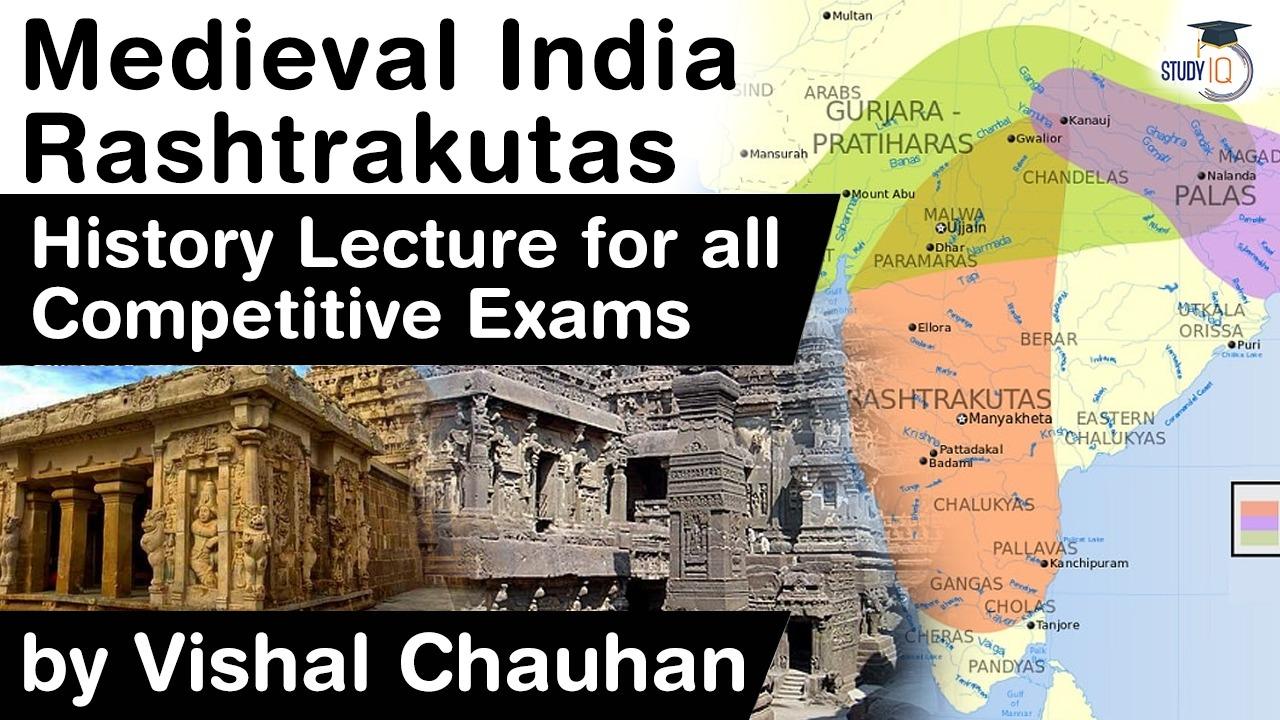Table of Contents
Introduction:
- After the death of Harshvardhana in the mid 7th century, the Pushyabhuti ruler, North India experienced a vacuum of central power as many feudatories of erstwhile dynasties had carved out for themselves independent States and were in a state of conflict to expand their frontiers.
- For a brief period of time Lalitaditya Muktapida of Karkota dynasty of Kashmir occupied Kannauj– the capital of Harshvardhana along with Punjab but was later compelled to give way to more powerful emerging powers.

- The Gujara-Pratihara and Palas were successful in filling up the power vacuum left after Harsha with the former ruling over West and latter in East.
- While in South India, the three branches of Chalukya dynasty emerged which ruled the peninsular India at various points of time with the Badami branch ruling the whole of South India in the early phase.
- After the fall of Badami branch, the Rashtrakutas and Eastern Chalukas of Vengi emerged.
- The adjacent rise of Gurjar-Pratihara in Malwa, Palas in Bengal and Rashtrakuttas in South India resulted in a tripartite struggle for the Dominion over North India.
- While in the far South, many prominent dynasties tried to assert their dominance in varied degrees, but Cholas of Tanjore under Vijayalaya emerged as the predominant power in the 9th century subsuming the Eastern Chalukyas.
- By the 10th century Rashtrakutas had declined which paved way for Chalukyas of Kalyani.
- In the 12th century with the fall of Chalukyas of Kalyani, dynasties such as Hoysala, Kakatiyas and Yadavas began to assert themselves in Peninsula and central India.
- Further, by the end of 13th century, Pandyas has reasserted themselves in southern India.

Rashtrakutas (755-975 CE):
- The Rashtrakutas were of Kannada origin and Kannada language was their mother tongue.
- Dantidurga:
- Dantidurga was the founder of Rashtrakuta dynasty.
- He is believed to have performed a ritual called Hiranya Garbha( literally, a Golden Womb).
- When this ritual was performed with the help of brahmanas, it was sought to lead to the “rebirth” of the sacrificer as a Kshatriya, even if he was not one by birth.
- He defeated the Gurjars and captured Malwa from them.
- He then annexed the Chalukyan Kingdom by defeating Kirtivarman II.
- Thus, the Rashtrakutas became Paramount power in Deccan.
- His successor Krishna I was also a great conqueror.
- Defeated the Gangas and the eastern Chalukyas of Vengi.
- He built the magnificent rock cut monolithic Kailasha temple at Ellora.
- The next important King of this dynasty was Govinda III(793-814).
- He achieved victories over North Indian kingdoms(Nagabhatta of Kannauj; Malwa).
- Amoghavarsha I:
- Govinda III’s successor Amoghavarsha I(814-878) ruled for a long period of 64 years.
- He had lost control over Malwa and Gangavadi.
- Yet, his reign was popular for the cultural development.
- He was a follower of Jainism.
- Jinasena was his chief preceptor.
- He was also a patron of letters and he himself wrote the famous Kannada work, Kavirajamarga.
- He also built the Rashtrakuta capital, the city of Malkhed or Manyakheda.
Krishna III(936-968):
- Among the successors of Amoghavarsha I, Krishna third, was famous for his Expeditions.
- He marched against the Chollas(Parantaka I;949) and defeated them at the Takkolam.
- He marched further South and captured Tanjore- capital of Chollas.
- He went as far as Rameshwaram(Pillar of Victory) and occupied it for some time.
- He built several temples in the conquered territories, including the Krishneswara temple at Rameshwaram.
- Throughout his reign he possessed the Tondaimandalam region, including the capital Kanchi.
- After his death, power of Rashtrakutas declined.



Administration:
- The Rashtrakuta empire was divided into several provinces called Rashtra is under the control of Rashtrapatis.
- They were further divided into Vaishyas or districts governed by Vaishayapatis.
- The next subdivision was Bhukti consisting of 50 to 70 villages under the control of Bhupatis.
- These officers were directly appointed by the central government.
- The village administration was carried on by village headman.
- However, the village assemblies played a significant role in the village administration.
Society and Economy:
- The Hindu sects of Vaishnavism and Shaivism flourished during the period of Rashtrakutas.
- Yet, it did not affect the progress of Jainism under the patronage of Rashtrakuta Kings and officers.
- Almost 1/3 of population of Deccan were Jain.
- There were some prosperous Buddhist settlements in places like Kanheri, Sholapur in Dharwar.
- There was harmony among various religions.


- There was a college at Salatogi, situated in modern Bijapur district.
- An inscription gives details of this educational center.
- It was run by the income from endowments made by rich as well as by the villages on occasions of functions and festivals.
- The economy was also in flourishing condition.
- There was an active Commerce between the deccan and the Arabs.
- The Rashtrakuta Kings promoted the Arab trade by maintaining friendship with them.


Cultural Contributions:
- The Rashtrakutas widely patronized the Sanskrit literature.
- There were many scholars in the Rashtrakuta court.
- Trivikarma wrote Nalachampu and the Kavirahasaya was composed by Halayudha during the reign of Krishna III.
- The Jain literature flourished under the patronage of Rashtrakutas.
- Amoghavarsha I, who was a Jain patronized many Jain scholars.
- His teacher Jinasena composed Parsavabhudaya, a biography of Parsva in verses.
- Another scholar Gunabhadra wrote the Adipurana, the life stories of various Jain saints.
- Sakatayana wrote the grammar work called Amogavriti.
- The great mathematician of this period, Viracharya was the author of Ganitasaram.
- The Kannada literature saw it’s begining during the period of Rashtrakutas.
- Amoghavarsha’s Kavirajamarga was the first poetic work in Kannada language.
- Pampa was the greatest of the Kannada poets.
- His famous work was Vikramsenavijaya.
- Ponna was another famous Kannada poet and he wrote Santipurana.
Art and Architecture:
- The art and architecture of Rashtrakutas were found Ellora and Elephanta.
- At Ellora, the most remarkable temple is the Kailasa temple.
- It was excavated during the reign of Krishna I.
- It is carved out of massive block of rock 200 feet long, and 100 feet in breadth and height.
- The Kailash temple is an architectural Marvel with its beautiful sculptures.
- The sculpture of the Goddess Durga is shown as slaying the Buffalo demon.




- In another sculpture Ravana was making attempts to lift Mount Kailasha, the abode of Shiva.
- The scenes of Ramayana were also depicted on the walls.
- The general characteristics of Kailasa temple are more Dravidian.
- Elephanta is an island near Mumbai.
- The sculpture art of Rashtrakutas reached its zenith in this place.
- There is a closer similarity between sculptures of Ellora and those in Elephanta.




- They might have been carved by the same Craftsman.
- In the walls of the Prakara around the sanctum there are niches containing the images of Shiva in various forms- Nataraja, Gangadhara, Ardhanareeswara and Somaskanda.
- The most imposing figure of this temple is Trimurthi.
- The sculpture is 6 metre high.
- It is said to represent the three aspects of Shiva as creator, preserver and destroyer.



























 WhatsApp
WhatsApp